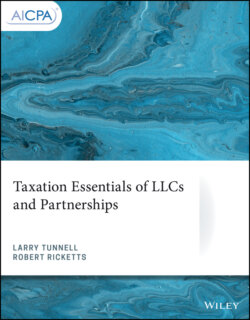Читать книгу Taxation Essentials of LLCs and Partnerships - Larry Tunnell - Страница 37
Example 1-19
ОглавлениеDale and Roy formed a partnership early this year. Dale contributed $100,000 cash in exchange for a 50% interest in the partnership. Roy contributed land with a tax basis of $60,000 and a fair market value of $100,000 in exchange for the remaining 50% interest in the partnership. The partnership will establish two sets of books and records. The first will record the land contributed by Roy at its $60,000 tax basis (which becomes the partnership's tax basis in the property under Section 723), along with the $100,000 cash contribution by Dale. In addition, this balance sheet will record Dale's capital contribution at $100,000, and Roy's at $60,000. The second set of records maintained by the partnership will reflect the book values of the two partnership assets, as well as Dale's and Roy's relative interests in those assets. On this set of books, the land will be recorded at its date of contribution value of $100,000, as will the cash. Dale's and Roy's capital accounts will each be $100,000. Therefore, the partnership's initial balance sheets will be as follows (amounts in thousands):
| Section 704(b) | |||
| Tax | Book | GAAP* | |
| Cash | $100 | $100 | $100 |
| Land | 60 | 100 | 100 |
| Total Assets | $160 | $200 | $200 |
| Capital, Dale | $100 | $100 | $100 |
| Capital, Roy | 60 | 100 | 100 |
| Total Liabilities and Capital | $160 | $200 | $200 |
* The partnership's initial balance sheet, reported on Schedule L of Form 1065 should generally agree with the partnership's books and records, which should be based on generally accepted accounting principles (GAAP). However, as discussed in a subsequent course, there are certain occasions in which the partnership is allowed to “revalue” its book balance sheet for tax purposes. Such revaluations may result in the partnership maintaining three sets of books and records—one accounting for the tax basis of partnership assets, another accounting for the Section 704(b) book value of those assets, and a third accounting for the GAAP book value of those assets.
Interpretation of the balance sheets is straightforward. The tax balance sheet indicates that the partnership has an aggregate basis in its assets of $160,000. Dale contributed $100,000 of this, and Roy contributed $60,000. Therefore, Dale stands to lose $100,000, although Roy stands to lose only $60,000, measured in historical cost terms. (Although Roy stands to lose $100,000 economically, $40,000 of this loss would be an opportunity loss.) In contrast, review of the book balance sheet indicates that the partnership has total assets with a market value (at date of contribution) of $200,000, of which $100,000 would go to Roy and $100,000 to Dale upon liquidation.
As illustrated in the previous example, capital accounts are maintained separately for each partner in the partnership. The capital account is increased by net contributions (that is, net of debt) to the partnership, and by the partner's share of partnership net income. It is decreased by net distributions received from the partnership, and by the partner's share of net partnership losses (if any). Therefore, the tax capital accounts summarize the basis of what each partner has invested in the partnership (tax balance sheet). The book capital accounts summarize what each partner is entitled to receive from the partnership at liquidation (book balance sheet).
